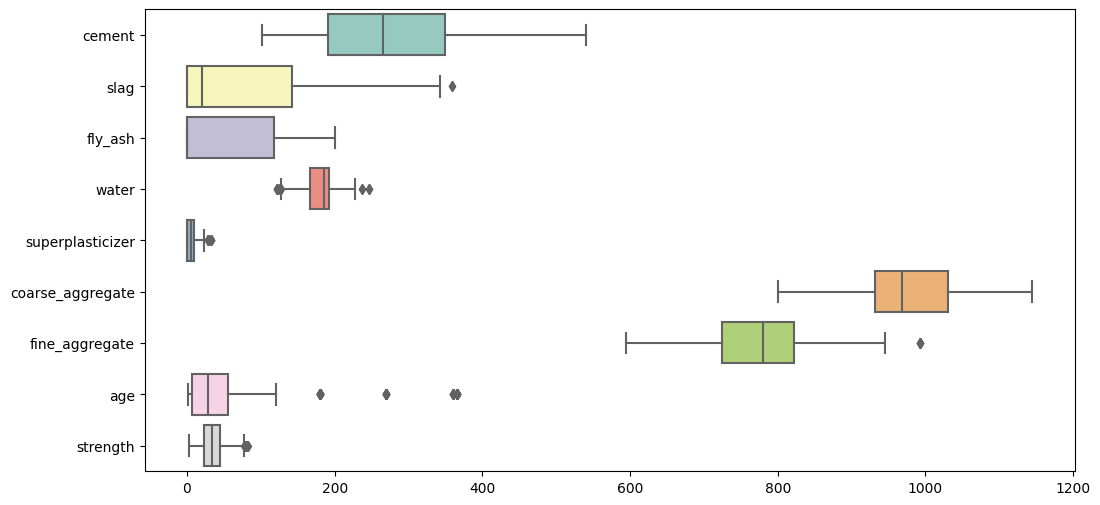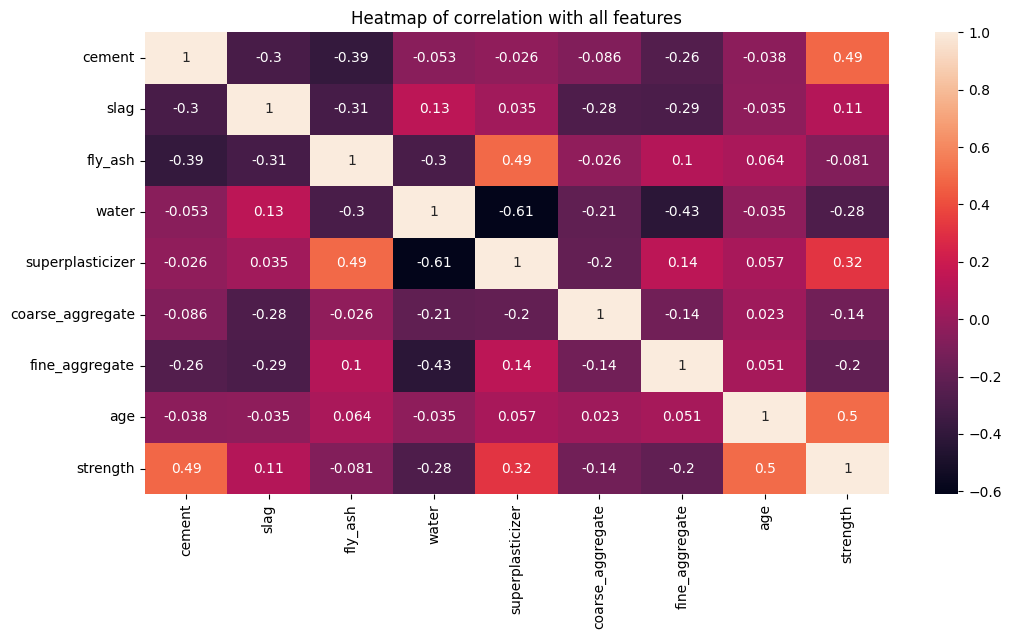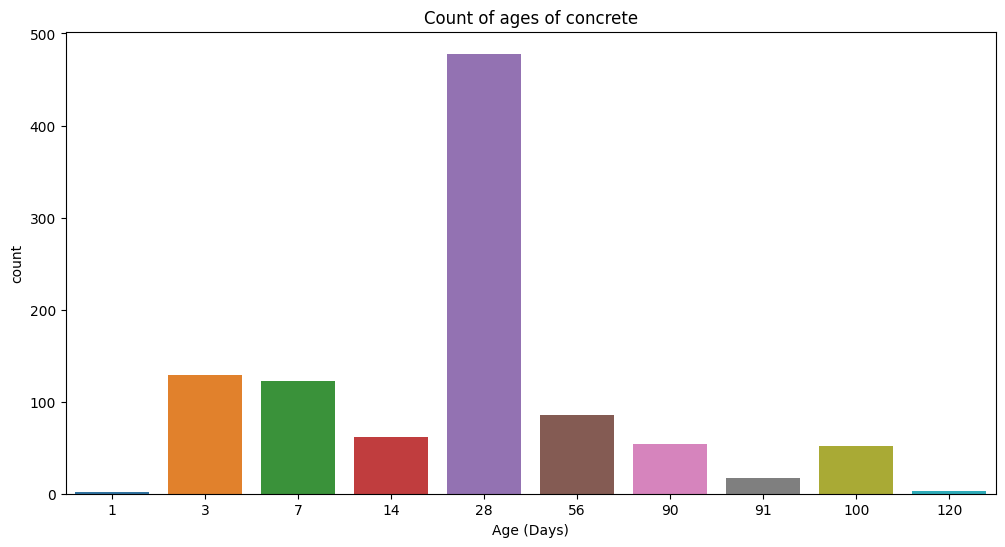Predict the strength of concrete#
📖 Background#
Concrete is the most widely used building material in the world. It is a mix of cement and water with gravel and sand. It can also include other materials like fly ash, blast furnace slag, and additives.
The compressive strength of concrete is a function of components and age, the team is testing different combinations of ingredients at different time intervals.
Find a simple way to estimate strength to predict how a particular sample is expected to perform.
The objective is to answer:
The average strength of the concrete samples at 1, 7, 14, and 28 days of age.
The coefficients of regression model using the formula that provided us:

💾 The data#
The team has already tested more than a thousand samples (source):
Compressive strength data:#
“cement” - Portland cement in kg/m3
“slag” - Blast furnace slag in kg/m3
“fly_ash” - Fly ash in kg/m3
“water” - Water in liters/m3
“superplasticizer” - Superplasticizer additive in kg/m3
“coarse_aggregate” - Coarse aggregate (gravel) in kg/m3
“fine_aggregate” - Fine aggregate (sand) in kg/m3
“age” - Age of the sample in days
“strength” - Concrete compressive strength in megapascals (MPa)
Acknowledgments: I-Cheng Yeh, “Modeling of strength of high-performance concrete using artificial neural networks,” Cement and Concrete Research, Vol. 28, No. 12, pp. 1797-1808 (1998).
Import Libraries#
import pandas as pd
import numpy as np
import matplotlib.pyplot as plt
import seaborn as sns
from sklearn.preprocessing import StandardScaler, OrdinalEncoder
from sklearn.model_selection import train_test_split, cross_val_score, KFold
from sklearn.pipeline import Pipeline
from sklearn.linear_model import LinearRegression, LogisticRegression
from sklearn.neighbors import KNeighborsRegressor
from sklearn.tree import DecisionTreeRegressor
from sklearn.ensemble import AdaBoostRegressor, RandomForestRegressor, BaggingRegressor, GradientBoostingRegressor
from sklearn.svm import SVR
from sklearn.model_selection import GridSearchCV
import tensorflow as tf
from sklearn.metrics import mean_squared_error, mean_absolute_error, r2_score
import warnings
warnings.filterwarnings("ignore")
2023-09-07 07:18:16.912242: I tensorflow/tsl/cuda/cudart_stub.cc:28] Could not find cuda drivers on your machine, GPU will not be used.
2023-09-07 07:18:16.963074: I tensorflow/tsl/cuda/cudart_stub.cc:28] Could not find cuda drivers on your machine, GPU will not be used.
2023-09-07 07:18:16.964611: I tensorflow/core/platform/cpu_feature_guard.cc:182] This TensorFlow binary is optimized to use available CPU instructions in performance-critical operations.
To enable the following instructions: AVX2 AVX512F FMA, in other operations, rebuild TensorFlow with the appropriate compiler flags.
2023-09-07 07:18:17.979345: W tensorflow/compiler/tf2tensorrt/utils/py_utils.cc:38] TF-TRT Warning: Could not find TensorRT
Load Data#
df = pd.read_csv('data/concrete_data.csv')
df.head()
| cement | slag | fly_ash | water | superplasticizer | coarse_aggregate | fine_aggregate | age | strength | |
|---|---|---|---|---|---|---|---|---|---|
| 0 | 540.0 | 0.0 | 0.0 | 162.0 | 2.5 | 1040.0 | 676.0 | 28 | 79.986111 |
| 1 | 540.0 | 0.0 | 0.0 | 162.0 | 2.5 | 1055.0 | 676.0 | 28 | 61.887366 |
| 2 | 332.5 | 142.5 | 0.0 | 228.0 | 0.0 | 932.0 | 594.0 | 270 | 40.269535 |
| 3 | 332.5 | 142.5 | 0.0 | 228.0 | 0.0 | 932.0 | 594.0 | 365 | 41.052780 |
| 4 | 198.6 | 132.4 | 0.0 | 192.0 | 0.0 | 978.4 | 825.5 | 360 | 44.296075 |
Data Preprocessing#
Data Size and Structure#
Dataset comprises of 1030 observations.
8 features and 1 target variable
strength.All columns are numerical
No null values
print(f'Shape: {df.shape} \n')
df.info()
Shape: (1030, 9)
<class 'pandas.core.frame.DataFrame'>
RangeIndex: 1030 entries, 0 to 1029
Data columns (total 9 columns):
# Column Non-Null Count Dtype
--- ------ -------------- -----
0 cement 1030 non-null float64
1 slag 1030 non-null float64
2 fly_ash 1030 non-null float64
3 water 1030 non-null float64
4 superplasticizer 1030 non-null float64
5 coarse_aggregate 1030 non-null float64
6 fine_aggregate 1030 non-null float64
7 age 1030 non-null int64
8 strength 1030 non-null float64
dtypes: float64(8), int64(1)
memory usage: 72.5 KB
Duplicated Data#
A small 2.43% of the dataset are duplicated. I decided to drop these, so now the dataset has 1005 observations.
dup_perc = df.duplicated().sum() / len(df) * 100
print(f'Duplicated percentage: {np.round(dup_perc, 2)}%')
df.drop_duplicates(inplace=True)
print(f'df shape after removing duplicates: {df.shape}')
Duplicated percentage: 2.43%
df shape after removing duplicates: (1005, 9)
Outliers#
Boxplots show that there are outliers in our data, but not many. We will be replacing these outliers with their median.
plt.figure(figsize=(12,6))
sns.boxplot(data=df, orient="h", palette="Set3")
plt.show()

for col_name in df.columns[:-1]:
q1 = df[col_name].quantile(0.25)
q3 = df[col_name].quantile(0.75)
iqr = q3 - q1
low = q1 - 1.5 * iqr
high = q3 + 1.5 * iqr
df.loc[(df[col_name] < low) | (df[col_name] > high), col_name] = df[col_name].median()
Summary Statistics#
Variance, skew, and kurtosis is also included.
We can see that all variables have skew are in asymmetric form.
desc = df.describe().T
desc['var'] = df.var(axis=0)
desc['skew'] = df.skew(axis=0)
desc['kurtosis'] = df.kurtosis(axis=0)
desc
| count | mean | std | min | 25% | 50% | 75% | max | var | skew | kurtosis | |
|---|---|---|---|---|---|---|---|---|---|---|---|
| cement | 1005.0 | 278.629055 | 104.345003 | 102.000000 | 190.680000 | 265.000000 | 349.00000 | 540.000000 | 10887.879601 | 0.564997 | -0.432463 |
| slag | 1005.0 | 71.367711 | 85.239740 | 0.000000 | 0.000000 | 20.000000 | 141.30000 | 342.100000 | 7265.813343 | 0.830465 | -0.524116 |
| fly_ash | 1005.0 | 55.535075 | 64.207448 | 0.000000 | 0.000000 | 0.000000 | 118.27000 | 200.100000 | 4122.596436 | 0.497324 | -1.366457 |
| water | 1005.0 | 182.521294 | 20.114500 | 127.300000 | 168.000000 | 185.700000 | 192.00000 | 228.000000 | 404.593097 | 0.126521 | -0.076357 |
| superplasticizer | 1005.0 | 5.791846 | 5.396851 | 0.000000 | 0.000000 | 6.100000 | 9.90000 | 23.400000 | 29.126001 | 0.514240 | -0.312220 |
| coarse_aggregate | 1005.0 | 974.376468 | 77.579534 | 801.000000 | 932.000000 | 968.000000 | 1031.00000 | 1145.000000 | 6018.584052 | -0.065242 | -0.583034 |
| fine_aggregate | 1005.0 | 771.628905 | 78.821267 | 594.000000 | 724.300000 | 780.000000 | 822.00000 | 945.000000 | 6212.792066 | -0.335220 | -0.198316 |
| age | 1005.0 | 32.117413 | 27.665333 | 1.000000 | 7.000000 | 28.000000 | 28.00000 | 120.000000 | 765.370663 | 1.312008 | 0.876534 |
| strength | 1005.0 | 35.250273 | 16.284808 | 2.331808 | 23.523542 | 33.798114 | 44.86834 | 82.599225 | 265.194960 | 0.395653 | -0.305402 |
Exploratory Data Analysis#
Correlation matrix#
Let’s look at the relationship between all the variables and their correlation.
From the heatmap, we observe target variable strength has a high positive correlation cement 0.49, superplasticizer 0.32, and age 0.5.
There is a strong negative correlation (-0.61) between superplasticizer and water.
plt.figure(figsize=(12,6))
sns.heatmap(df.corr(), annot=True)
plt.title('Heatmap of correlation with all features')
plt.show()

Age#
Age is a very important characteristic that affects concrete strength.
plt.figure(figsize=(12,6))
sns.countplot(x='age', data=df)
plt.title(label="Count of ages of concrete")
plt.xlabel("Age (Days)")
plt.show()

This bar plot shows that age is a categorical variable with a high number of observations at 28 days.
The 28 days time frame is significant because this is the period for concrete to reach 99% of it’s strength. While the concrete continuous to gain strength after that period, the rate of gain is much less compared to that in 28 days.
avg_str_by_day = df.groupby('age').agg(['mean', 'count'])['strength']
avg_str_by_day.reset_index(inplace=True)
avg_str_by_day.age = avg_str_by_day.age.astype(int)
avg_str_by_day = avg_str_by_day.style.set_caption("Average concrete strength at different ages (Days):")
print(f'Average concrete strength: {df.strength.mean()} \n')
avg_str_by_day
Average concrete strength: 35.25027287623584
| age | mean | count | |
|---|---|---|---|
| 0 | 1 | 9.452716 | 2 |
| 1 | 3 | 18.378023 | 129 |
| 2 | 7 | 25.181843 | 122 |
| 3 | 14 | 28.751038 | 62 |
| 4 | 28 | 37.383788 | 478 |
| 5 | 56 | 50.715152 | 86 |
| 6 | 90 | 40.480809 | 54 |
| 7 | 91 | 68.674649 | 17 |
| 8 | 100 | 47.668780 | 52 |
| 9 | 120 | 39.647168 | 3 |
From the table we can see that average concrete strength at 28 days is similar to the average strength of the entire dataset.
plt.figure(figsize=(12,6))
sns.boxplot(x='age', y='strength', data=df);
plt.title(label="Boxplot of concrete strength at different ages")
plt.xlabel("Age (Days)")
plt.ylabel("Strength")
plt.show()

In this boxplot, concrete strength is the highest at 91 days. They have the highest median strenght with a narrow variation. We can also see that strength has the largest variation at 28 days.
1. Average strength of the concrete samples at 1, 7, 14, and 28 days of age.#
Average strength of concrete is the lowest after 1 day and increases significantly after 7 days. Strength continues to increase in MPa after 14 and 28 days.
ages = [1, 7, 14, 28]
for age in ages:
cond = df.age == age
avg_str = df[cond].strength.mean().round(2)
if age == 1:
print(f'Average strength of the concrete sample is {avg_str} MPa at {age} day.')
else:
print(f'Average strength of the concrete sample is {avg_str} MPa at {age} days.')
Average strength of the concrete sample is 9.45 MPa at 1 day.
Average strength of the concrete sample is 25.18 MPa at 7 days.
Average strength of the concrete sample is 28.75 MPa at 14 days.
Average strength of the concrete sample is 37.38 MPa at 28 days.
2. Creating predictive model#
Now let’s help our colleages in the engineering department find out the coefficients \(\beta_{0}\), \(\beta_{1}\) … \(\beta_{8}\), to use in the following formula:

Train Test Split#
Split the data to train (80%) and test (20%) to estimate the performance of machine learning algorithms when they are used to make predictions on data not used to train the model.
features = ['cement', 'slag', 'fly_ash', 'water', 'superplasticizer', 'coarse_aggregate', 'fine_aggregate', 'age']
X = df[features] # Features
y = df['strength'] # Target
# Train Test Split
X_train, X_test, y_train, y_test = train_test_split(X, y, test_size=0.2, random_state=2022)
print('X train data {}'.format(X_train.shape))
print('y train data {}'.format(y_train.shape))
print('X test data {}'.format(X_test.shape))
print('y test data {}'.format(y_test.shape))
X train data (804, 8)
y train data (804,)
X test data (201, 8)
y test data (201,)
Encoding age#
We observed that age is a variabel comprised of a finite set of discrete values with a ranked ordering between values.
def ordinal_encoding_feature(data, feature):
'''Transform selected column with ordinal encoder
INPUTS:
data: dataframe
feature: column name
OUTPUT:
d: dataframe with feature ordinally encoded
'''
d = data.copy()
encoder = OrdinalEncoder()
# Reshape because only one column is transformed
encoder.fit(data[feature].values.reshape(-1,1))
d[feature]= encoder.transform(data.age.values.reshape(-1,1))
return d
X_train = X_train.pipe(ordinal_encoding_feature, 'age')
X_test = X_test.pipe(ordinal_encoding_feature, 'age')
Model Selection#
We will be using a supervised regression model since the target variable strength is labeled and continuous.
Using k-folds cross validation to estimate and compare the performance of models on out-of-sample data using r2 score. This enables us to identify which model is worth improving upon.
GradientBoostRegressor gives the best results out of models, with the highest r2score of 0.89.
pipelines = []
pipelines.append(('Linear Regression', Pipeline([('scaler', StandardScaler()), ('LR', LinearRegression())])))
pipelines.append(('KNN Regressor', Pipeline([('scaler', StandardScaler()), ('KNNR', KNeighborsRegressor())])))
pipelines.append(('SupportVectorRegressor', Pipeline([('scaler', StandardScaler()), ('SVR', SVR())])))
pipelines.append(('DecisionTreeRegressor', Pipeline([('scaler', StandardScaler()), ('DTR', DecisionTreeRegressor())])))
pipelines.append(('AdaboostRegressor', Pipeline([('scaler', StandardScaler()), ('ABR', AdaBoostRegressor())])))
pipelines.append(('RandomForestRegressor', Pipeline([('scaler', StandardScaler()), ('RBR', RandomForestRegressor())])))
pipelines.append(('BaggingRegressor', Pipeline([('scaler', StandardScaler()), ('BGR', BaggingRegressor())])))
pipelines.append(('GradientBoostRegressor', Pipeline([('scaler', StandardScaler()), ('GBR', GradientBoostingRegressor())])))
# Create empty dataframe to store the results
cv_scores = pd.DataFrame({'Regressor':[], 'R2':[], 'Std':[]})
# Cross-validation score for each pipeline for training data
for ind, val in enumerate(pipelines):
name, pipeline = val
kfold = KFold(n_splits=5)
score = cross_val_score(pipeline, X_train, y_train, cv=kfold, scoring="r2")
cv_scores.loc[ind] = [name, score.mean(), score.std()]
cv_scores
| Regressor | R2 | Std | |
|---|---|---|---|
| 0 | Linear Regression | 0.766578 | 0.026529 |
| 1 | KNN Regressor | 0.788847 | 0.023574 |
| 2 | SupportVectorRegressor | 0.702593 | 0.018576 |
| 3 | DecisionTreeRegressor | 0.803986 | 0.018346 |
| 4 | AdaboostRegressor | 0.764470 | 0.013887 |
| 5 | RandomForestRegressor | 0.882420 | 0.012613 |
| 6 | BaggingRegressor | 0.874642 | 0.009321 |
| 7 | GradientBoostRegressor | 0.885524 | 0.011444 |
Model Tuning#
Using Grid Search to tune hyperparameters of Gradient Boosting Regressor.
steps = [('scaler', StandardScaler()), ('GBR', GradientBoostingRegressor())]
pipeline = Pipeline(steps)
param_grid=[{'GBR__n_estimators':[100,500,1000],
'GBR__learning_rate': [0.1,0.05,0.02,0.01],
'GBR__max_depth':[4,6],
'GBR__min_samples_leaf':[3,5,9,17],
'GBR__max_features':[1.0,0.3,0.1] }]
#search = GridSearchCV(pipeline, param_grid, cv = 5, scoring = 'r2', n_jobs=-1, verbose=1)
#search.fit(X_train, y_train)
#print(search.best_estimator_)
#print("R Squared:", search.best_score_)
Now that we have identified the best model, let’s use it to predict on our unseen data X_test.
#best_model = search.best_estimator_
# Let's hardcode the parameters to save time
best_model = Pipeline(steps=[('GBR',
GradientBoostingRegressor(learning_rate=0.05, max_depth=6,
max_features=0.3,
min_samples_leaf=17,
n_estimators=1000))])
es = tf.keras.callbacks.EarlyStopping(monitor = 'val_loss', mode='min',patience=5, verbose=1)
best_model.fit(X_train, y_train)
Pipeline(steps=[('GBR',
GradientBoostingRegressor(learning_rate=0.05, max_depth=6,
max_features=0.3,
min_samples_leaf=17,
n_estimators=1000))])In a Jupyter environment, please rerun this cell to show the HTML representation or trust the notebook. On GitHub, the HTML representation is unable to render, please try loading this page with nbviewer.org.
Pipeline(steps=[('GBR',
GradientBoostingRegressor(learning_rate=0.05, max_depth=6,
max_features=0.3,
min_samples_leaf=17,
n_estimators=1000))])GradientBoostingRegressor(learning_rate=0.05, max_depth=6, max_features=0.3,
min_samples_leaf=17, n_estimators=1000)y_pred = best_model.predict(X_test)
Model Evaluation#
Let’s evaluate the model’s performance on the testing data to assess the likely future performance of a model.
print(f'Mean Absolute Error (MAE): {mean_absolute_error(y_test, y_pred)}')
print(f'Mean Squared Error (MSE): {mean_squared_error(y_test, y_pred)}')
print(f'RMSE: {mean_squared_error(y_test, y_pred)**0.5}')
print(f'R2 Score: {r2_score(y_test, y_pred)}')
Mean Absolute Error (MAE): 6.2759229895533535
Mean Squared Error (MSE): 63.96244441213967
RMSE: 7.997652431316309
R2 Score: 0.7505082963525445
Feature Importance#
Using the feature importance of the model, we get the coefficients \(\beta_{0}\), \(\beta_{1}\) … \(\beta_{8}\), to use in the following formula:

betas = best_model[0].feature_importances_
plt.figure(figsize=(12,6))
plt.barh(features, betas)
plt.show()

betas_dict = dict(zip(features, betas))
beta_0 = np.mean(y - np.sum(X*betas, axis=1))
print(f"Concrete Strength = {beta_0} +")
for key in betas_dict.keys():
if key == "age":
print(f"{betas_dict[key]} * {key}")
else:
print(f"{betas_dict[key]} * {key} +")
Concrete Strength = -167.60301467047782 +
0.25458955256773314 * cement +
0.05994450275185537 * slag +
0.040991604189364705 * fly_ash +
0.13184936195092536 * water +
0.06189292503419931 * superplasticizer +
0.043905713867143197 * coarse_aggregate +
0.06097535136626531 * fine_aggregate +
0.3458509882725137 * age

